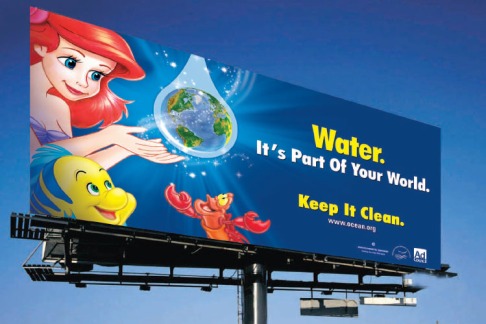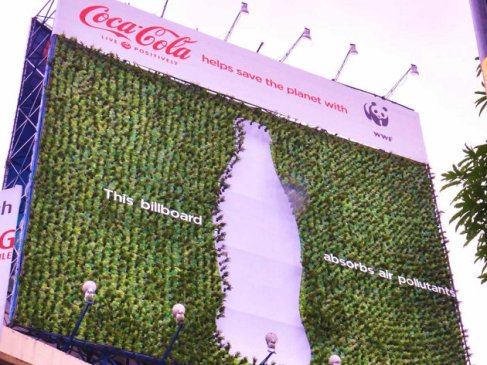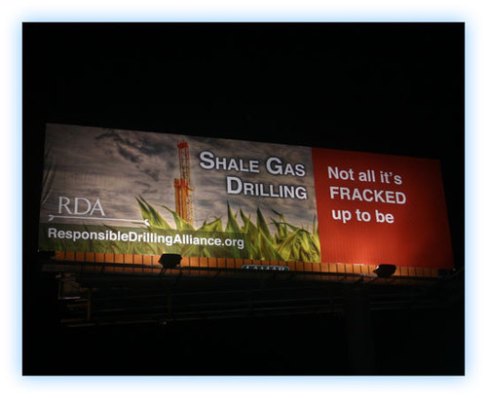Environmental Advertising: The Billboard Side of Life
A billboard by the World Wildlife Fund that uses an awning that raises throughout the day to show that water levels in the oceans are rising.
Environmental advertising is becoming a common aspect of daily life, but research on the effects of green advertising have only been around since the 1990s. The ads include anything from “save the trees” campaigns to promotions of the latest green household product. Environmentalists are constantly trying to send messages to the public to make people think and act to make the world a better place. To do so, they use a variety of media, such as billboards, radio ads, and television. Trying to create more effective advertising, advertisers are making creative billboards. People are exposed to radio and television everyday, but they do not always see billboard ads. If that is true, why are they still utilized? How effective are they? What techniques are being used to make these billboards work? This article delves into the world of billboard advertising to break down how it works and what makes it successful.
Advantages, Advantages, Advantages
Billboard advertising has been used for many years, mostly for products, but has been increasing in movements, causes and services. In recent years, outdoor advertising has grown, billboards being the most common example of this movement within advertisements (Taylor, Franke, and Bang 21). Since 2001, the spending on outdoor advertising has surpassed $5.1 billion (Taylor and Franke 105). The appeal of using billboards comes from the advantages they give companies. These advantages include: potential placement of the ad close to the point of sale, high frequency of exposure to regular commuters, high reach, a 24-hour presence, geographic flexibility for local advertisers, economic efficiency in terms of low costs of production, visual impact from advertisement size and message creativity, and lastly, brand awareness (Taylor, Franke, and Bang 22). The plethora of advantages heavily outweighs the disadvantages, such as word number limitations, small exposure, demographic selectivity, and measurements. However, these minor setbacks have not taken away from the success of billboards, as they have rated high than other forms of media in communicating affordably, attracting new customers, and increasing sales (Taylor, Franke, and Bang 22). The success that companies have from billboards is the reason that they are still being used today.
Here is a unique billboard promoting a water blackout in order to conserve water. It stands out because the colors are bright, and the use of the pole as the water hose is quite innovative.
Why Should I Look?
Billboard advertising has many factors and obstacles that make it continually demanding. One such obstacle is the exposure consumers have to ads. On average, a consumer sees nearly one million ads per year (Taylor, Franke, and Bang 22). Because of this, people are selective about the ads they pay attention to, ignoring most of them. The selectiveness is a four-part process that involves exposure, attention, comprehension, and retention. By having selective exposure, people limit the messages they see and hear and have them conform to their already existing ideas (Taylor, Franke, and Bang 23). If it does not fit into the ideals they already hold, they will most likely ignore the message. Selective attention occurs when the person truly pays attention to the ad after he or she has seen it (Taylor, Franke, and Bang 23). The next step is selective comprehension, which happens when the consumer connects the ad’s content with his or her beliefs. The last step, selective retention, is known as the consumer remembering ads that are consistent with existing beliefs and self-image (Taylor, Franke, and Bang 23). For advertisers to make their ads successful, they need to go through this process before consumers see the ad.
This is an example of advertisers catering to a specific audience; in this case, it is targeting people with children and avid Disney lovers.
Billboards have a unique advantage that other media do not. Other media does not surround billboards, which allows it tot be the focal point (Taylor, Franke, and Bang 23). There is not as big as a competition for the consumer. This aspect makes up for the short contact to the consumer. The lack of competition also allows for consumers to see the ad when ready to buy something, making billboards an appeal to retail stores. The location is pertinent to success of the ad. Results found in a study by Allaway, Berkowitz, and D’Souza support the idea that the closer a billboard is to a store, the more likely a consumer is to shop at it (Taylor, Franke, and Bang 23). This is particularly true when a consumer is looking for a place to eat, as the restaurant is closer to the billboard. Advertisers continually use billboards today because they have the ability to reach consumers in a unique, effective way that cannot be achieved through radio or television ads.
Save the Planet! Bike to Work!
The effectiveness of billboard advertisements not only benefits companies, but they can also bring awareness to causes and movements, such as environmental issues. A study by Ricky Chan examines the effectiveness of environmental advertising in China to show whether different nations react the same to environmental messages. Environmental awareness in China has slowly risen over the years, which has caused environmental advertising to spring up quickly. As the industry continues to grow, the country’s ecological system has taken a major turn for the worse. The government is taking steps to better the environment, such as enacting anti-pollution laws, and some consumers are starting to be more careful of their purchases (Chan 351). However, most of the population only supports the green movement through words, not actions or purchases. This has caused advertisers who are marketing green products to find more effective ways to connect the support for a better environment to purchasing greener products.
It is difficult to persuade through environmental advertising as people often become skeptical of the claims being made (Chan 352). Chinese citizens want advertisements to be real and honest, so skepticism does not make them want to be green. For marketers to be successful, they have to use different techniques. Using the country’s green image, as a whole, is effective in trying to get consumers to purchase environmentally friendly products. The results of the study concluded that consumers would be more likely to buy green products when the advertisements appealed to them from a national angle. This just proves that environmental advertisements are hard to persuade people to act, and billboards have the ability to change that.
Here is an example of a Chinese environmental billboard advocating for wildlife.
Why Should I Care? It Doesn’t Impact My Community!
In environmental advertising, there are three levels and audiences that are trying to be reached and influenced, which include the macro, meso, and micro levels. The macro level entails broad messaging and global environment saving. The meso level of advertising focuses on services and products to help out macro and micro causes. Micro environmental advertising includes those trying to better their community or area in the world by tackling its major issues (Fowler 119). These levels are not as effective or cohesive as they could be due to a phenomenon called the green gap. There is disconnect between what the consumer believes should be done to improve the environment and protect the earth and what he or she really does to improve the environment (Fowler 119). The green gap shows that advertisers ask for action that is too large-scale, promoting being green just for their own benefit, or asking too small tasks of the consumers.
It’s All About the Consumer
Consumers are not responding to the messages because they say that being green is too costly, the government should take care of the environment, or the environment has to suffer to keep the standard of economic development that is currently in place (Fowler 121). These rationales do not correlate with the consumers want for the environment to be safer and protected. These attitudes affect environmental advertising directly because, although they make an impact at first, they are quickly ignored. When this happens, the advertisements do not create the intended impact that is meant to occur. Examples of these are the American Society for the Prevention of Cruelty to Animals’ animal cruelty advertisements. They have an impact for a moment, but then people become numb to it, ignoring the tragic happenings.
One example of environmental advertising that focuses on the cost of being green, making it more unlikely for consumers to respond to it.
Part of the reason that environmental advertising is not being effective to its full potential is that different advertisers have agendas that do not line up with each other. There may be ads on the same subject, but people do not adhere to them because they do not follow the same aspects. Also, people may be concerned about saving the environment, but not on the global scale that many advertisements advocate for. They will act if it will affect their immediate environment, but there are often not ads to support that or supply ideas to do so. To implement action through consumers, environmental advertisers need to target the community aspect in their crusade to save the world. Individual actions can make a difference, but many do not consider that or find it inconvenient (Fowler 129).
That is Quite Re“fresh”ing
While some advertisers try to affect change through direct, informational messages, some companies are using unconventional techniques to show support for a better environment. McDonald’s does not seem like the company that would promote being green, but a billboard advertisement for fresh salads has done just that. In 2007, McDonald’s launched a fresh salad campaign that a turn for the green, environment that is. In Chicago, a man names Leo Burnett used 16 varieties of lettuce to create a billboard that said, “FRESH SALADS.” The lettuce was tended to daily to make sure that it was still fresh and healthy. Not only did this risky billboard grow McDonald’s business, it helped to create a greener atmosphere in Chicago! To watch the progression of the billboard, click here. This advertisement, though innovative and green, does not take away the fact that McDonald’s salads contain pesticides, but it could be the company’s way of making up for it.
End result of the McDonald’s “Fresh Salads” campaign.
Billboards have the power to influence people to do things: shop, open an account at a bank, and now, enact change. How people see billboards affects the changes that occur. It is the duty of the advertiser to be creative and unconventional so that his or her message connects to the people and creates a reaction. People unknowingly choose the ads they want to acknowledge and act on. Environmental advertisers should use this as an advantage, not a disadvantage, and create ads that are not only visible, but also relatable. It might take a statistic, or even a billboard full of lettuce.
Here are some more examples of environmental billboards (All photos courtesy of Google Images):
This ad is interesting, not only because of the message, but the target audience that is being reached. This ad is for those who are always stuck in rush hour traffic coming to and from work.
Here is an ad that is not only promoting the Coca-Cola brand, but is being green at the same time. It is similar to the McDonald’s billboard only in the fact that they both use plants. This ad specifically promotes the green aspect by blatantly saying that the sign is absorbing air pollutants.
This billboard, by Denver Water, is a unique way to send a message. It is not only advocating being careful of water use, but also electricity use. It brings a different perspective and makes the audience realize how much electricity goes into keeping billboard signs lit at night.
This advertisement is very blunt. The advertisers attack the issue of fracking while not being too wordy and giving the curious consumer a link to learn more.
This billboard is using emotion to try to enact change in people. The choice of using a little girl is direct and targeting families.
Eskom is deliberate in this ad, clearly in support of electricity conservation., not only by the message, but by the decision to only use one light to advertise.
Chan, Ricky Y.K. “The Effectiveness Of Environmental Advertising: The Role Of Claim Type and The Source Country Green Image.” International Journal Of Advertising 19.3 (2000): 349-375. Communication & Mass Media Complete. Web. 13 May 2013.
Fowler III A, Close A. “It Ain’t Easy Being Green.” Journal Of Advertising 41.4 (2012): 119-132. Communication & Mass Media Complete. Web. 8 May 2013
Taylor, Charles R., and George R. Franke. “Business Perceptions Of The Role Of Billboards In The U.S. Economy.” Journal Of Advertising Research 43.2 (2003): 150-161. Communication & Mass Media Complete. Web. 8 May 2013.
Taylor, Charles R., George R. Franke, and Bang Hae-Kyong. “Use And Effectiveness Of Billboards.” Journal Of Advertising 35.4 (2006): 21-34. Communication & Mass Media Complete. Web. 13 May 2013.
Wheaton, Ken, and Emily Bryson York. “McDonald’s Gives New Meaning To Green Advertising.” Advertising Age 78.40 (2007): 48. Communication & Mass Media Complete. Web. 8 May 2013.












Very nicely researched! Do you advocate the use of billboards for pro-environmental messages because it’s cost effective, or because it’s important to break up the more consumer-driven kinds of messages motorists often see?
Such eye catching advertisements often become landmarks. Yes it is to catch the attention of the people of course. I like the the first billboard ie.., about the rising water levels in the oceans.Wild on Media at Toronto has done several such interesting advertisement billboards and sky murals.